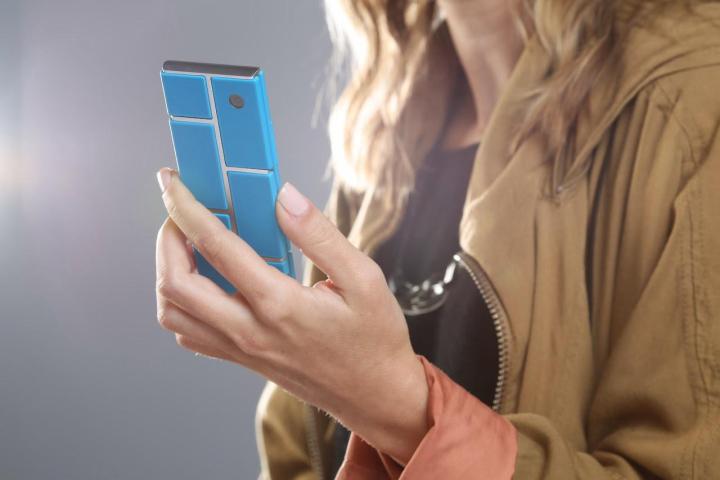
We identify ourselves with the things we own — the clothes we wear, the cars we drive, the gadgets. It’s not ideal, sure, but it’s a major consequence of living in a capitalist society; where we choose to spend our hard-earned money plays a major role in how we distinguish ourselves from others. But as smartphones continue to play an ever more integral role in our lives, the gulf separating one product from the next, has shrunken considerably in recent years.
In a world of “hardware as platform,” we’ve come to accept this relative uniformity. Buy a phone from any of the leading manufacturers and you’ll get a nice piece of hardware, largely comprised of the same components. Customization is the role of software, thanks millions of third-party apps. But why shouldn’t hardware be as flexible? The simple answer is that hardware it’s a lot more time consuming, expensive and generally resource intensive to create a smartphone than a smartphone app. It’s the reason there are a lot more stories about dorm room app store billionaires than hardware startups.
It’s easy to foresee a time when hardware partners create hardware concepts phone manufacturers had never dreamed of.
Google took things to the next level last year with the Moto X. While, again, the components remained the same, Moto Maker opened up myriad aesthetic choices, with a rainbow of colors, accents and materials, bringing a new level of customization to world of consumer electronics. The company proceeded to take things even further with Project Ara, a modular smartphone concept that attempts to do for the innards of handsets what Moto Maker did for their exterior with a framework that allows for the customization of displays, keyboards, batteries, cameras, etc.
Heck, the project, which Google has cannily referred to as the phone design for “six billion people,” offers up far more options that even its creators have envisioned — and that’s really the beauty here. After all, what has made the app store such a success is the realization that even a company with Apple’s bank account has finite resources. By farming out a feature set to thousands of app developers, the product’s draw is limited only to the imagination of all parties involved. If hardware can take the same path, it’s easy to foresee a time when hardware partners create hardware concepts phone manufacturers had never dreamed of.
For anyone who’s ever identified with a particular technology brand, there’s an unquestionable appeal in the ability to truly make a piece of hardware to order. How many times have you wished you could upgrade your battery, add more storage or maybe a better camera than currently offered by the manufacturer? We already favor companies that most closely align with our ideal of a product, but personalization could take us the extra couple of steps toward our perfect device. As manufacturers scramble for features to set them apart from the competition, such modularity feels like the next natural step. You can only get so far increasing the screen size by a fraction of an inch every year.

This kind of customization feels right at home with other trends in technology, most notably the crowd-funding phenomenon. Where only a few years ago the phrase “hardware startup” might have come off as something of an oxmoron, sites like Kickstarter and Indiegogo are making products like the Pebble smartwatch and Oculus Rift realities. This, coupled with a more accessible manufacturing chain and a steady drop in the price of components thanks to the smartphone wars, has made it possible for small startups to target hardware to smaller groups.
Then there’s the phenomenon that MakerBot’s Bre Pettis has excitedly referred to as “the next industrial revolution,” as technologies like 3D printing and user-friendly mass market micro controllers like Arduino and Raspberry Pi have made at-home prototyping much more viable. As industrial 3D printing technology continues to advance in all manner of different materials, it’s not too difficult to envision a time in the not-so-distant future in which we’ll simply enter our parameters into a computer and simply wait for the gadget to print out.
In the meantime, however, concepts like Project Ara feel like an important step toward truly customizable devices, while working within the confines of the technologies that are currently available. Online ordering will, naturally, be the glue that holds this future together. Once the backend manufacturing is in place, customizing devices will be a simple matter of ticking the right boxes and pressing Submit.
We’re heading toward the modularity sooner or later, and the push of companies like Google will only help us arrive there faster. It looks like a bright future for consumer electronics — after all, if we’re already using our devices to define who we are, shouldn’t we have some input in defining our devices?
Editors' Recommendations
- Have one of these Google Pixel phones? You’re getting Circle to Search
- These are the 5 smartwatches you should look forward to in 2024
- Google can create the perfect Pixel phone — if it changes one thing
- The 15 most important smartphones that changed the world forever
- Your Google One plan just got 2 big security updates to keep you safe online

